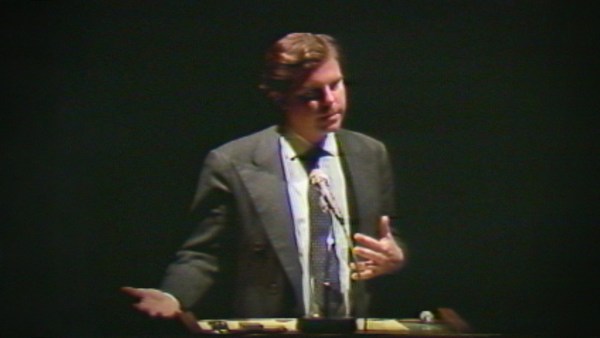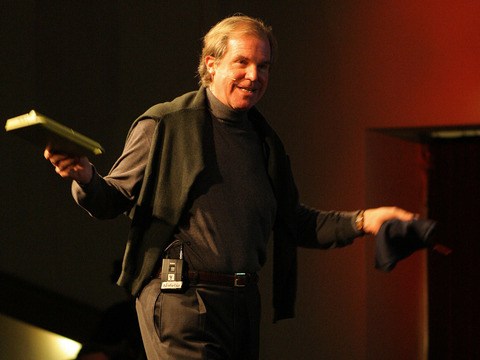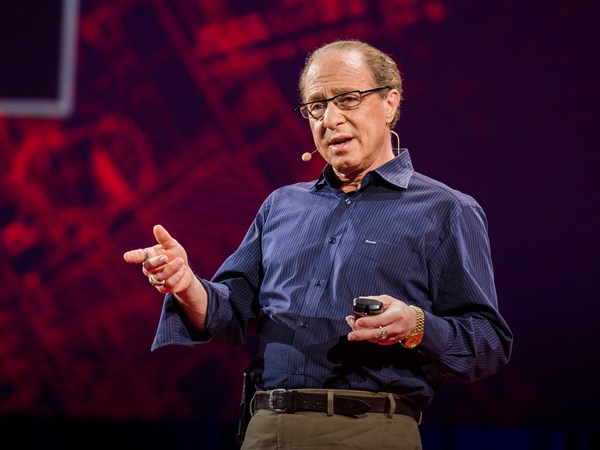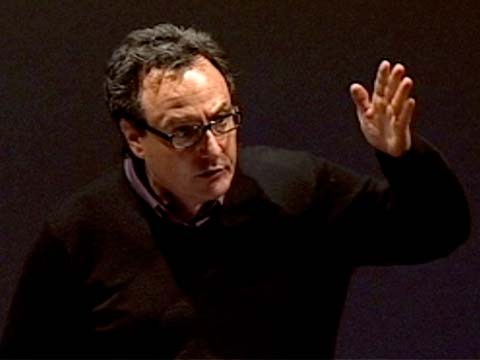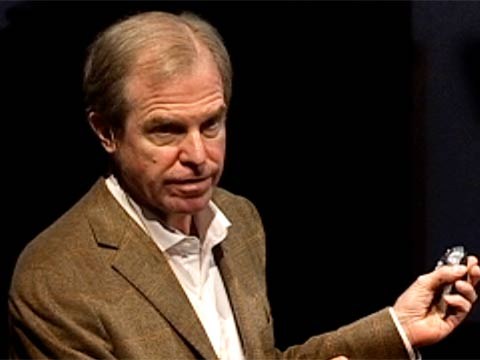(Video) Nicholas Negroponte: Can we switch to the video disc, which is in play mode?
I'm really interested in how you put people and computers together. We will be using the TV screens or their equivalents for electronic books of the future. (Music, crosstalk) Very interested in touch-sensitive displays, high-tech, high-touch, not having to pick up your fingers to use them. There is another way where computers touch people: wearing, physically wearing. Suddenly on September 11th, the world got bigger.
NN: Thank you. (Applause)
Thank you.
When I was asked to do this, I was also asked to look at all 14 TED Talks that I had given, chronologically. The first one was actually two hours. The second one was an hour, and then they became half hours, and all I noticed was my bald spot getting bigger. (Laughter) Imagine seeing your life, 30 years of it, go by, and it was, to say the least, for me, quite a shocking experience. So what I'm going to do in my time is try and share with you what happened during the 30 years, and then also make a prediction, and then tell you a little bit about what I'm doing next. And I put on a slide where TED 1 happened in my life. And it's rather important because I had done 15 years of research before it, so I had a backlog, so it was easy. It's not that I was Fidel Castro and I could talk for two hours, or Bucky Fuller. I had 15 years of stuff, and the Media Lab was about to start. So that was easy.
But there are a couple of things about that period and about what happened that are really quite important. One is that it was a period when computers weren't yet for people. And the other thing that sort of happened during that time is that we were considered sissy computer scientists. We weren't considered the real thing. So what I'm going to show you is, in retrospect, a lot more interesting and a lot more accepted than it was at the time.
So I'm going to characterize the years and I'm even going to go back to some very early work of mine, and this was the kind of stuff I was doing in the '60s: very direct manipulation, very influenced as I studied architecture by the architect Moshe Safdie, and you can see that we even built robotic things that could build habitat-like structures. And this for me was not yet the Media Lab, but was the beginning of what I'll call sensory computing, and I pick fingers partly because everybody thought it was ridiculous. Papers were published about how stupid it was to use fingers. Three reasons: One was they were low-resolution. The other is your hand would occlude what you wanted to see, and the third, which was the winner, was that your fingers would get the screen dirty, and hence, fingers would never be a device that you'd use. And this was a device we built in the '70s, which has never even been picked up. It's not just touch sensitive, it's pressure sensitive.
(Video) Voice: Put a yellow circle there.
NN: Later work, and again this was before TED 1 —
(Video) Voice: Move that west of the diamond. Create a large green circle there. Man: Aw, shit.
NN: — was to sort of do interface concurrently, so when you talked and you pointed and you had, if you will, multiple channels.
Entebbe happened. 1976, Air France was hijacked, taken to Entebbe, and the Israelis not only did an extraordinary rescue, they did it partly because they had practiced on a physical model of the airport, because they had built the airport, so they built a model in the desert, and when they arrived at Entebbe, they knew where to go because they had actually been there. The U.S. government asked some of us, '76, if we could replicate that computationally, and of course somebody like myself says yes. Immediately, you get a contract, Department of Defense, and we built this truck and this rig. We did sort of a simulation, because you had video discs, and again, this is '76. And then many years later, you get this truck, and so you have Google Maps.
Still people thought, no, that was not serious computer science, and it was a man named Jerry Wiesner, who happened to be the president of MIT, who did think it was computer science. And one of the keys for anybody who wants to start something in life: Make sure your president is part of it. So when I was doing the Media Lab, it was like having a gorilla in the front seat. If you were stopped for speeding and the officer looked in the window and saw who was in the passenger seat, then, "Oh, continue on, sir." And so we were able, and this is a cute, actually, device, parenthetically. This was a lenticular photograph of Jerry Wiesner where the only thing that changed in the photograph were the lips. So when you oscillated that little piece of lenticular sheet with his photograph, it would be in lip sync with zero bandwidth. It was a zero-bandwidth teleconferencing system at the time.
So this was the Media Lab's — this is what we said we'd do, that the world of computers, publishing, and so on would come together. Again, not generally accepted, but very much part of TED in the early days. And this is really where we were headed. And that created the Media Lab. One of the things about age is that I can tell you with great confidence, I've been to the future. I've been there, actually, many times. And the reason I say that is, how many times in my life have I said, "Oh, in 10 years, this will happen," and then 10 years comes. And then you say, "Oh, in five years, this will happen." And then five years comes. So I say this a little bit with having felt that I'd been there a number of times, and one of the things that is most quoted that I've ever said is that computing is not about computers, and that didn't quite get enough traction, and then it started to. It started to because people caught on that the medium wasn't the message. And the reason I show this car in actually a rather ugly slide is just again to tell you the kind of story that characterized a little bit of my life. This is a student of mine who had done a Ph.D. called "Backseat Driver." It was in the early days of GPS, the car knew where it was, and it would give audio instructions to the driver, when to turn right, when to turn left and so on. Turns out, there are a lot of things in those instructions that back in that period were pretty challenging, like what does it mean, take the next right? Well, if you're coming up on a street, the next right's probably the one after, and there are lots of issues, and the student did a wonderful thesis, and the MIT patent office said "Don't patent it. It'll never be accepted. The liabilities are too large. There will be insurance issues. Don't patent it." So we didn't, but it shows you how people, again, at times, don't really look at what's happening.
Some work, and I'll just go through these very quickly, a lot of sensory stuff. You might recognize a young Yo-Yo Ma and tracking his body for playing the cello or the hypercello. These fellows literally walked around like that at the time. It's now a little bit more discreet and more commonplace.
And then there are at least three heroes I want to quickly mention. Marvin Minsky, who taught me a lot about common sense, and I will talk briefly about Muriel Cooper, who was very important to Ricky Wurman and to TED, and in fact, when she got onstage, she said, the first thing she said was, "I introduced Ricky to Nicky." And nobody calls me Nicky and nobody calls Richard Ricky, so nobody knew who she was talking about. And then, of course, Seymour Papert, who is the person who said, "You can't think about thinking unless you think about thinking about something." And that's actually — you can unpack that later. It's a pretty profound statement.
I'm showing some slides that were from TED 2, a little silly as slides, perhaps. Then I felt television really was about displays. Again, now we're past TED 1, but just around the time of TED 2, and what I'd like to mention here is, even though you could imagine intelligence in the device, I look today at some of the work being done about the Internet of Things, and I think it's kind of tragically pathetic, because what has happened is people take the oven panel and put it on your cell phone, or the door key onto your cell phone, just taking it and bringing it to you, and in fact that's actually what you don't want. You want to put a chicken in the oven, and the oven says, "Aha, it's a chicken," and it cooks the chicken. "Oh, it's cooking the chicken for Nicholas, and he likes it this way and that way." So the intelligence, instead of being in the device, we have started today to move it back onto the cell phone or closer to the user, not a particularly enlightened view of the Internet of Things. Television, again, television what I said today, that was back in 1990, and the television of tomorrow would look something like that. Again, people, but they laughed cynically, they didn't laugh with much appreciation.
Telecommunications in the 1990s, George Gilder decided that he would call this diagram the Negroponte switch. I'm probably much less famous than George, so when he called it the Negroponte switch, it stuck, but the idea of things that came in the ground would go in the air and stuff in the air would go into the ground has played itself out. That is the original slide from that year, and it has worked in lockstep obedience.
We started Wired magazine. Some people, I remember we shared the reception desk periodically, and some parent called up irate that his son had given up Sports Illustrated to subscribe for Wired, and he said, "Are you some porno magazine or something?" and couldn't understand why his son would be interested in Wired, at any rate.
I will go through this a little quicker. This is my favorite, 1995, back page of Newsweek magazine. Okay. Read it. (Laughter)
["Nicholas Negroponte, director of the MIT Media Lab, predicts that we'll soon buy books and newspapers straight over the Internet. Uh, sure." —Clifford Stoll, Newsweek, 1995]
You must admit that gives you, at least it gives me pleasure when somebody says how dead wrong you are.
"Being Digital" came out. For me, it gave me an opportunity to be more in the trade press and get this out to the public, and it also allowed us to build the new Media Lab, which if you haven't been to, visit, because it's a beautiful piece of architecture aside from being a wonderful place to work. So these are the things we were saying in those TEDs.
[Today, multimedia is a desktop or living room experience, because the apparatus is so clunky. This will change dramatically with small, bright, thin, high-resolution displays. — 1995]
We came to them. I looked forward to it every year. It was the party that Ricky Wurman never had in the sense that he invited many of his old friends, including myself.
And then something for me changed pretty profoundly. I became more involved with computers and learning and influenced by Seymour, but particularly looking at learning as something that is best approximated by computer programming. When you write a computer program, you've got to not just list things out and sort of take an algorithm and translate it into a set of instructions, but when there's a bug, and all programs have bugs, you've got to de-bug it. You've got to go in, change it, and then re-execute, and you iterate, and that iteration is really a very, very good approximation of learning.
So that led to my own work with Seymour in places like Cambodia and the starting of One Laptop per Child. Enough TED Talks on One Laptop per Child, so I'll go through it very fast, but it did give us the chance to do something at a relatively large scale in the area of learning, development and computing. Very few people know that One Laptop per Child was a $1 billion project, and it was, at least over the seven years I ran it, but even more important, the World Bank contributed zero, USAID zero. It was mostly the countries using their own treasuries, which is very interesting, at least to me it was very interesting in terms of what I plan to do next. So these are the various places it happened.
I then tried an experiment, and the experiment happened in Ethiopia. And here's the experiment. The experiment is, can learning happen where there are no schools. And we dropped off tablets with no instructions and let the children figure it out. And in a short period of time, they not only turned them on and were using 50 apps per child within five days, they were singing "ABC" songs within two weeks, but they hacked Android within six months. And so that seemed sufficiently interesting. This is perhaps the best picture I have. The kid on your right has sort of nominated himself as teacher. Look at the kid on the left, and so on. There are no adults involved in this at all. So I said, well can we do this at a larger scale? And what is it that's missing? The kids are giving a press conference at this point, and sort of writing in the dirt. And the answer is, what is missing? And I'm going to skip over my prediction, actually, because I'm running out of time, and here's the question, is what's going to happen?
I think the challenge is to connect the last billion people, and connecting the last billion is very different than connecting the next billion, and the reason it's different is that the next billion are sort of low-hanging fruit, but the last billion are rural. Being rural and being poor are very different. Poverty tends to be created by our society, and the people in that community are not poor in the same way at all. They may be primitive, but the way to approach it and to connect them, the history of One Laptop per Child, and the experiment in Ethiopia, lead me to believe that we can in fact do this in a very short period of time.
And so my plan, and unfortunately I haven't been able to get my partners at this point to let me announce them, but is to do this with a stationary satellite. There are many reasons that stationary satellites aren't the best things, but there are a lot of reasons why they are, and for two billion dollars, you can connect a lot more than 100 million people, but the reason I picked two, and I will leave this as my last slide, is two billion dollars is what we were spending in Afghanistan every week. So surely if we can connect Africa and the last billion people for numbers like that, we should be doing it.
Thank you very much.
(Applause)
Chris Anderson: Stay up there. Stay up there.
NN: You're going to give me extra time?
CA: No. That was wickedly clever, wickedly clever. You gamed it beautifully. Nicholas, what is your prediction? (Laughter)
NN: Thank you for asking. I'll tell you what my prediction is, and my prediction, and this is a prediction, because it'll be 30 years. I won't be here. But one of the things about learning how to read, we have been doing a lot of consuming of information going through our eyes, and so that may be a very inefficient channel. So my prediction is that we are going to ingest information You're going to swallow a pill and know English. You're going to swallow a pill and know Shakespeare. And the way to do it is through the bloodstream. So once it's in your bloodstream, it basically goes through it and gets into the brain, and when it knows that it's in the brain in the different pieces, it deposits it in the right places. So it's ingesting.
CA: Have you been hanging out with Ray Kurzweil by any chance?
NN: No, but I've been hanging around with Ed Boyden and hanging around with one of the speakers who is here, Hugh Herr, and there are a number of people. This isn't quite as far-fetched, so 30 years from now.
CA: We will check it out. We're going to be back and we're going to play this clip 30 years from now, and then all eat the red pill.
Well thank you for that.
Nicholas Negroponte.
NN: Thank you.
(Applause)
